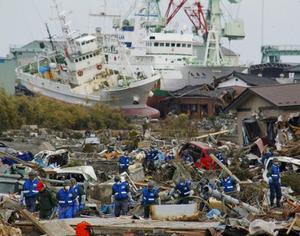DisastersJapan begins road to recovery
Japan’s long road to recovery has already begun; it is estimated that more than 135,000 buildings were destroyed and the Japanese government estimates that the recovery will cost as much as $310 billion; in the Miyagi prefecture, 80 miles from the quake’s epicenter, construction will soon begin on 1,110 temporary homes to shelter the more than 243,000 people who are now homeless; authorities are struggling to provide those living in shelters with enough food, clothing, and sanitary supplies; experts believe that Japan can rebuild quickly; Miyagi plans on building 10,000 temporary homes

Miyagi prefecture faces a long road to recovery // Source: ibtimes.com
Japan’s long road to recovery has already begun after the 11 March earthquake and tsunami decimated much of the country’s low lying towns and industry in the northeast. It is estimated that more than 135,000 buildings were destroyed or damaged and that least 10,000 people were killed.
In the Miyagi prefectureconstruction will soon begin on 1,110 temporary homes to shelter the more than 243,000 people who are now homeless.
According to Masanori Takahashi, a spokesman for Miyagi’s department of public works, the local government will begin construction in thirteen cities and towns with the first phase taking about a month to complete.
The Miyagi prefecture and the nearby Iwate and Fukushima prefectures were hit the hardest by the disasters. Sendai, the capital of Miyagi, is located eighty miles from the epicenter of the 9.0 magnitude earthquake.
Two weeks after the disaster, authorities are struggling to provide those living in shelters with enough food, clothing, and sanitary supplies. Even after residents return to their homes or move into temporary housing, officials will likely need to continue supplying basic necessities for two to three months.
In Iwate 383 shelters have reported that cases of influenza are spreading and medical teams have had difficulty reaching shelters to deliver medicine.
Takahashi said that the government’s top priority was moving people back into homes and out of the shelters.
“There are too many challenges to list, but the priority is to provide housing that has all the necessities to live a normal life,” he said.
Miyagi plans on building 10,000 temporary homes while the Fukushima prefecture, where crews are struggling to contain radiation leaks from overheating reactors, will build 14,000 units.
Officials say that residents may live in the temporary homes for at least two years without having to pay rent. The units include toilets, baths, lighting, kitchens with gas stoves, and air conditioning.
Following the devastating Kobe earthquake in 1995, Japan made a surprisingly quick recovery and some observers believe that the country will rebound similarly once more.
The Japanese government estimates that the recovery will cost as much as $310 billion, roughly 6 percent of GDP.
Eduardo Kausel, a professor of civil and environmental engineering at the Massachusetts Institute of Technology (MIT), believes that the areas hardest hit by the disasters can rebuild quickly.
“Traditional, low-lying Japanese houses and buildings are mostly of low cost and quick to build, as befits a country that has lived with the threat of earthquakes for centuries. So theoretically it’s quite possible that many of the worst-hit areas could be rebuilt quickly,” he says.
The first step to rebuilding areas hit by the earthquake will be to send structural engineers to assess buildings. Their primary two goals will be to study how the latest earthquake proof technology and building codes fared and to inspect buildings for any structural damage.
Kausel writes in MIT’s Technology Review that the resilience of Japan’s buildings have proven that their construction techniques were successful. Even if buildings contain damaged components and must be destroyed, it is not a failure.
He says, “It’s a success: the building withstood the quake. For decades, that’s been the primary aim of quake-proofing—preserving human life and avoiding extensive damage during moderate but oft-recurring earthquakes, not constructing buildings that can survive unscathed even after a monster earthquake like this one.”
But Kausel urges the Japanese government to reconsider building towns and critical infrastructure in low-lying areas that were ravaged by the tsunami.
“With earthquakes such a fact of life in Japan, and the relatively shallow seas of northeastern Japan making the area particularly vulnerable to a tsunami, I hope the Japanese authorities act responsibly, and if necessary, relocate and redesign entire towns and villages, as well as future nuclear power stations. We know now that you can’t tsunami-proof a town or building; all you can do is move it out of the way.”
